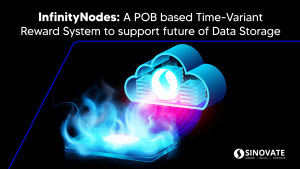Infinity Nodes: Proof-of-Burn Time-Variant Reward System for Data Storage
The text below is an advertorial article that was not written by Cryptonews.com journalists.

In June 2019, SINOVATE released the first-of-its-kind technological feature which exploits the power of the Proof-of-Burn (PoB) mechanism called Infinity Nodes. In 2020, the AURORA release pushed the technology in its uniqueness by integrating LockReward and deterministic rewards. Here are some of the features which make SINOVATE the only time-variant reward system currently in the crypto sphere.
What is SINOVATE?
SINOVATE (SIN) is an innovative state-of-the-art blockchain for decentralized cloud storage launched in 2018. Established as a Decentralized Autonomous Organization (DAO), SINOVATE offers a decentralized Cloud (dCloud) multi-chain ecosystem to answer the future challenges of Big Data and Artificial Intelligence. The network runs with Bitcoin core 0.21 to exploit Layer-2 protocols such as smart contracts or state channels for micropayments based on the Lightning Network or decentralized applications to provide services.
The SINOVATE coin was launched in 2018 and is currently traded under the ticker ‘SIN’ on several top crypto exchanges. SIN has a total circulating supply of over 700 million coins with a global market cap of over 2M USD. SIN is currently ranked under the top 1400 cryptocurrencies.
What is the Proof-of-Burn (PoB) mechanism in SINOVATE?
The Proof-of-Burn (PoB) was conceived as a self-regulating mechanism for the supply and demand of coins in circulation. This regulation is made by transferring transaction fees and more to an unusable SIN address. They are then said to be burnt, which is one of the main functions of the PoB mechanism. As the ledger is public and open to everyone, the unusable generic address of the project(below) makes it possible to trace all transactions and actions linked to the PoB mechanism: SinBurnAddress123456789SuqaXbx3AMC
In SINOVATE, the PoB mechanism is applied to different network functionalities such as transaction fees or governance vote fees. This allows SINOVATE to have a particular economic model by fighting supply inflation. One of the characteristics specific to SINOVATE is that it has extended this principle to the PoSe layer of its blockchain, where nodes are called Infinity Nodes.
Reminder on the Infinity Nodes PoSe layer
Like other blockchain solutions, the main SINOVATE chain relies on hundreds of nodes spread across the globe, beyond all borders or proper jurisdiction. In the PoSe layer, each node hosts a replica of the main chain, allowing the ledger’s authenticity. They help support the network by providing their owners with additional custom-made, unique, and advanced functionalities that cannot be provided by simple network full-nodes such as data storage or fast payments. In return, the blockchain delivers a reward to holders of Infinity Nodes for each confirmation of transaction blocks alongside the PoW and PoS layers.
Additionally, SINOVATE uses a custom codebase established from scratch for the nodes of its PoSe layer. It requires the future owner to commit a 12-month eligibility contract with the network by sending the collateral to the unspendable address. The owner can select a different number of SIN coins depending on 3 Tiers. This network organization is an interesting distinction compared to the initial Masternode technologies, although existing in some contemporary Masternode projects.
Each Tier seen as a layer of the network provides different and distinct functions to ensure both decentralization, overall network stability, and data storage service, the major strength of the SINOVATE project. Each level requires a different number of coins to create a node which is defined for the:
- MINI Tier: 100 000 SIN coins
- MID Tier: 500 000 SIN coins
- BIG Tier: 1 000 000 SIN coins
Hence, the Infinity Node will receive rewards from generated blocks according to the payment round. It will enable the participants to retrieve the burnt collateral with additional income. This payment round is fully deterministic and depends on the number of active Infinity Nodes in the Tier because of the 12-month contract commitment. After 12 months, the Infinity Node expires, and the owner should have collected the burnt collateral, and additional incomes with all the received block rewards. The collateral is not returned at the end of the contract. With Constellation release, the data storage increases the additional income by storing data.
12-month contract for time-variant reward system
The 12-month contract commitment leads to a limited lifespan of every Infinity Node. The frequency of received rewards may vary over time which is very different from the masternodes system, where the frequency is mainly decreasing. Hence, when the Infinity Nodes were released in June 2019, the ROI of Infinity was considerably huge for all the Tiers. In December 2019, the limits of Infinity Nodes had been removed. It did not create an ROI increase, but more MID and BIG nodes have been created. With AURORA release in December 2020, MINI Tier receives an increase of rewards, allowing a temporary higher ROI. The following figure resumes the different ROI variations over time.
Hence, the introduction of Infinity Nodes creates different waves of expiration for the different Tiers of the network. Today, two waves of expirations can be noticed: In June/July and December/January of every year. People are investing in SINOVATE plays with these waves, and people who own nodes can enjoy a temporary ROI Increase.

SINOVATE aims to deliver an extensive data storage network, and Infinity Nodes are the medium of storage. To increase its capacity, SINOVATE aims to create new Tiers or to increase the capacity of the existing ones by changing the block rewards. These decisions will benefit investors and the data storage network. For instance, the expiration wave of June/July 2021 would expect an increase of ROI between 30 to 40% for MID and BIG holders.
{no_ads}



